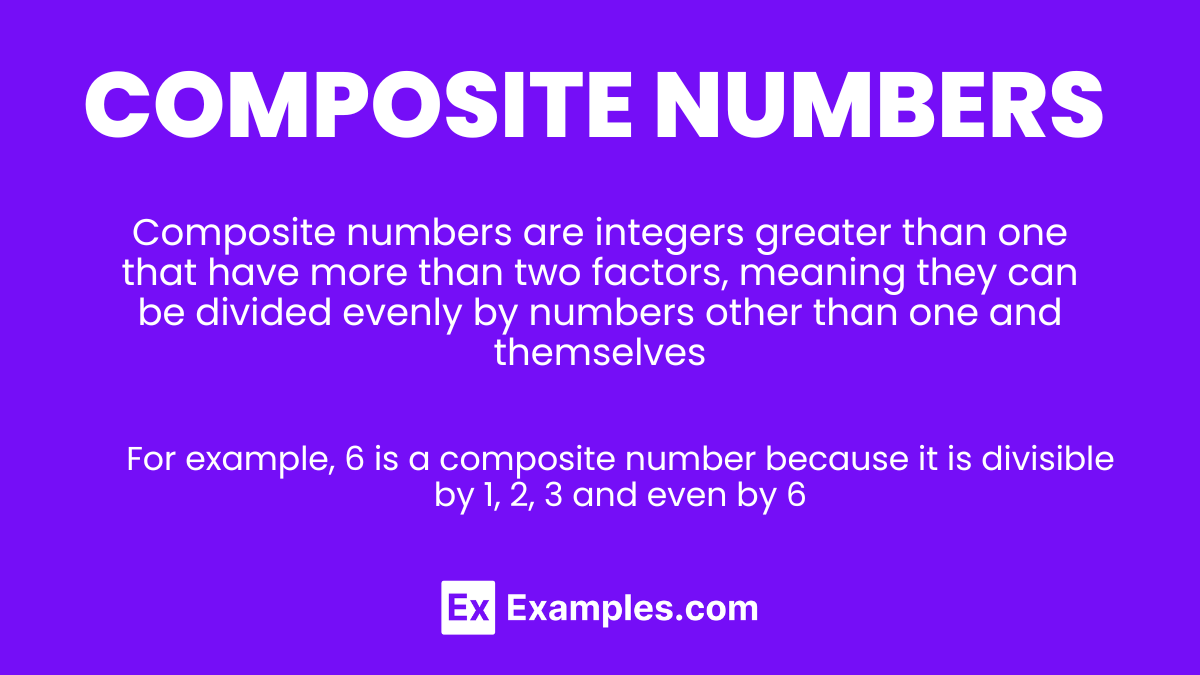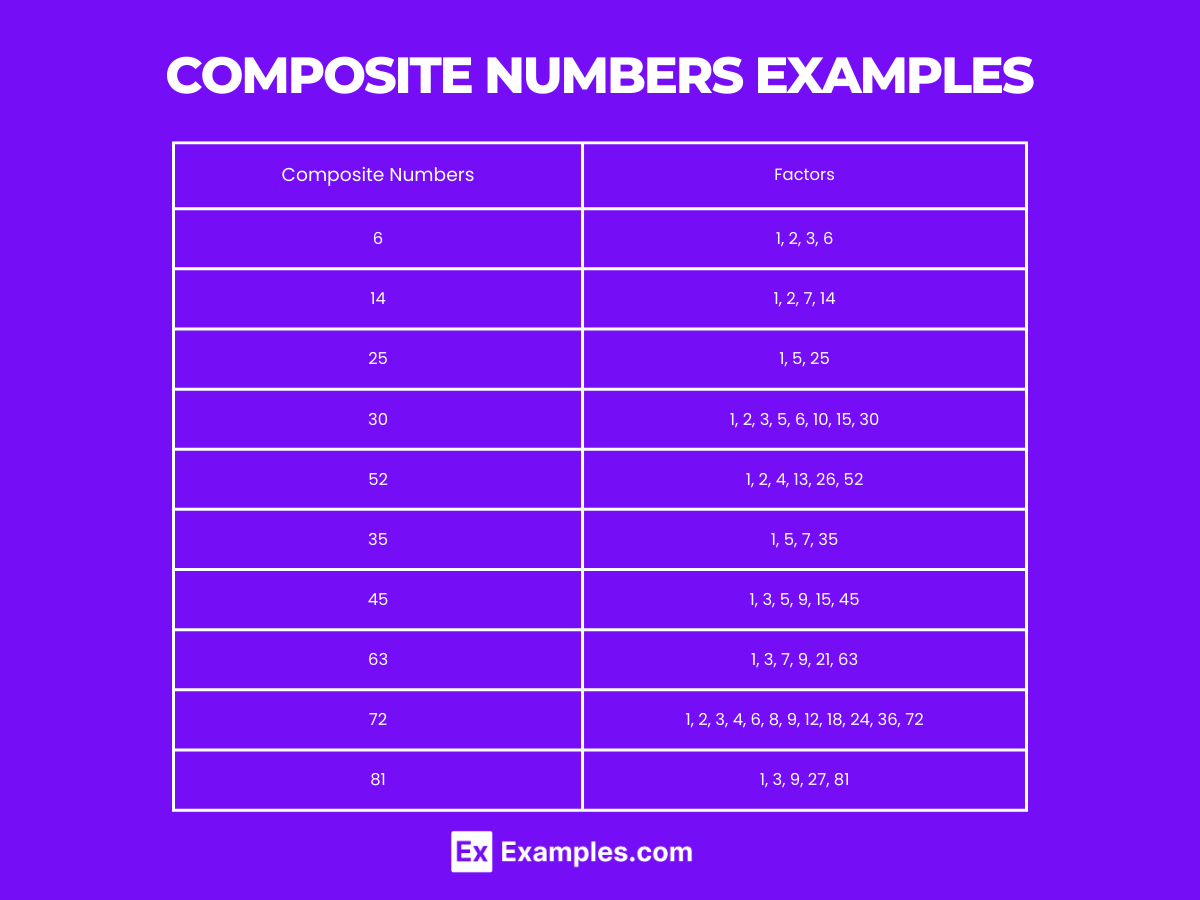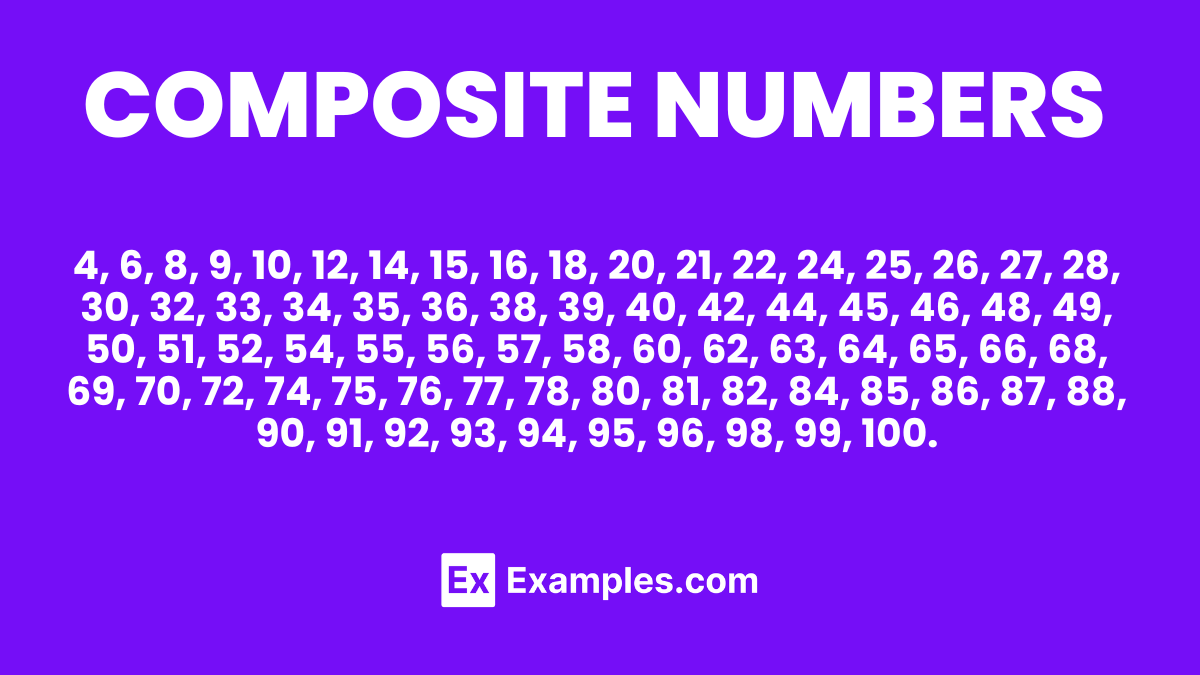What is the smallest composite number?
2
3
4
5


Composite Numbers with our comprehensive guide, designed to make mathematics engaging and accessible for educators and students. This resource unravels the complexity of composite numbers, offering clear definitions, vivid examples, and practical applications. By bridging the gap between abstract concepts and tangible understanding, we aim to enhance mathematical literacy, foster curiosity, and empower learners to explore the vast landscape of numbers with confidence.
Composite numbers are integers greater than one that have more than two factors, meaning they can be divided evenly by numbers other than one and themselves. Unlike prime numbers, which are only divisible by one and themselves, composite numbers can be broken down into smaller factors. This concept is crucial in the study of mathematics, offering a foundation for understanding divisibility, factorization, and the fundamental theorem of arithmetic.
A prime example of a composite number is 4. It is greater than one and has three factors: 1, 2, and 4. Unlike a prime number, which only has two distinct factors, 4 can be evenly divided by 2, showcasing its composite nature. This illustrates the basic principle of composite numbers — they are the building blocks of mathematics, enabling the exploration of more complex concepts such as factorization and the study of number properties.

| Composite Numbers | Factors |
|---|---|
| 6 | 1, 2, 3, 6 |
| 14 | 1, 2, 7, 14 |
| 25 | 1, 5, 25 |
| 30 | 1, 2, 3, 5, 6, 10, 15, 30 |
| 52 | 1, 2, 4, 13, 26, 52 |
| 35 | 1, 5, 7, 35 |
| 45 | 1, 3, 5, 9, 15, 45 |
| 63 | 1, 3, 7, 9, 21, 63 |
| 72 | 1, 2, 3, 4, 6, 8, 9, 12, 18, 24, 36, 72 |
| 81 | 1, 3, 9, 27, 81 |
Composite numbers are integers that have at least one divisor other than 1 and themselves. They play a significant role in various mathematical concepts and applications. Understanding composite numbers helps students grasp the basics of number theory, factorization, and divisibility rules, enhancing their problem-solving skills.
Examples:
The properties of composite numbers are crucial for understanding their behavior within the number system. These properties assist in distinguishing composite numbers from primes and play a vital role in various mathematical operations and problem-solving.
Properties:

4, 6, 8, 9, 10, 12, 14, 15, 16, 18, 20, 21, 22, 24, 25, 26, 27, 28, 30, 32, 33, 34, 35, 36, 38, 39, 40, 42, 44, 45, 46, 48, 49, 50, 51, 52, 54, 55, 56, 57, 58, 60, 62, 63, 64, 65, 66, 68, 69, 70, 72, 74, 75, 76, 77, 78, 80, 81, 82, 84, 85, 86, 87, 88, 90, 91, 92, 93, 94, 95, 96, 98, 99, 100, 102, 104, 105, 106, 108, 110, 111, 112, 114, 115, 116, 117, 118, 119, 120, 121, 122, 123, 124, 125, 126, 128, 129, 130, 132, 133, 134, 135, 136, 138, 140, 141, 142, 143, 144, 145, 146, 147, 148, 150, 152, 154, 155, 156, 157, 158, 159, 160, 162, 164, 165, 166, 168, 170, 172, 174, 175, 176, 177, 178, 180, 182, 184, 185, 186, 187, 188, 189, 190, 192, 194, 195, 196, and 198.
Discovering composite numbers involves identifying integers greater than one that are divisible by at least one other number besides one and themselves. This process is essential for strengthening mathematical understanding and analytical skills. By employing divisibility tests, learners can efficiently distinguish composite numbers from primes, enhancing their ability to navigate through various mathematical challenges. This knowledge forms the backbone of arithmetic and number theory, serving as a crucial step in the exploration of factors, multiples, and the structure of numbers.
Examples:
Composite numbers are categorized based on their factors and the uniqueness of these factors. Understanding the different types enriches mathematical discussions and problem-solving strategies, offering a nuanced view of number theory. This segmentation helps in identifying patterns and applying mathematical concepts more effectively, particularly in factorization and the study of prime factorials.
Examples:
The smallest composite number is 4. It’s the first integer greater than 1 that is not prime, as it can be divided evenly by 1, 2, and itself. Understanding this concept is pivotal for students beginning to explore the realm of number theory, providing a clear starting point for identifying and classifying numbers based on their factors. This foundational knowledge is essential for grasping more complex mathematical concepts.
Examples:
Understanding the difference between prime and composite numbers is crucial for students to navigate through basic arithmetic and number theory. Prime numbers have exactly two distinct positive divisors: 1 and themselves. In contrast, composite numbers have more than two divisors, making them divisible by at least one other number besides 1 and themselves.
| Feature | Prime Numbers | Composite Numbers |
|---|---|---|
| Definition | Numbers greater than 1 that have exactly two factors: 1 and themselves. | Numbers greater than 1 that have more than two factors. |
| Examples | 2, 3, 5, 7, 11 | 4, 6, 8, 9, 10 |
| Divisibility | Can only be divided evenly by 1 and the number itself. | Can be divided evenly by at least one other number besides 1 and itself. |
| Factor Count | Exactly two distinct factors. | More than two distinct factors. |
| Factorization | Cannot be broken down into other prime numbers. | Can be broken down into smaller prime numbers. |
| First Instance | 2 (the only even prime number) | 4 (the smallest composite number) |
| Nature | Building blocks of all numbers. | Made up of prime numbers multiplied together. |
| Composite Number | Prime Factorization |
|---|---|
| 4 | 2 x 2 |
| 6 | 2 x 3 |
| 8 | 2 x 2 x 2 |
| 9 | 3 x 3 |
| 10 | 2 x 5 |
| 12 | 2 x 2 x 3 |
| 15 | 3 x 5 |
| 18 | 2 x 3 x 3 |
| 20 | 2 x 2 x 5 |
| 24 | 2 x 2 x 2 x 3 |
| 25 | 5 x 5 |
| 30 | 2 x 3 x 5 |
| 36 | 2 x 2 x 3 x 3 |
| 40 | 2 x 2 x 2 x 5 |
| 45 | 3 x 3 x 5 |
| 50 | 2 x 5 x 5 |
| 60 | 2 x 2 x 3 x 5 |
| 72 | 2 x 2 x 2 x 3 x 3 |
| 80 | 2 x 2 x 2 x 2 x 5 |
| 90 | 2 x 3 x 3 x 5 |
| 100 | 2 x 2 x 5 x 5 |
Prime factorization of composite numbers involves breaking down a composite number into a set of prime numbers that, when multiplied together, give the original number. This process is fundamental in mathematics, enabling the simplification of fractions, finding the greatest common divisors, and solving a variety of problem types.
Examples:
Question: Is 15 a composite number?
Solution: Yes, 15 is a composite number because it has more than two divisors. It can be divided evenly by 1, 3, 5, and 15.
Question: What is the smallest composite number?
Solution: The smallest composite number is 4. It’s the first number after 1 that is not a prime number, with divisors being 1, 2, and 4.
Question: What is the prime factorization of 18?
Solution: The prime factorization of 18 is 2 x 3 x 3. This shows that 18 can be divided into prime numbers 2 and 3, where 3 is used twice.
Question: Verify if 22 is a composite number and provide its prime factorization.
Solution: Yes, 22 is a composite number because it has divisors other than 1 and itself. Its prime factorization is 2 x 11, indicating it can be divided by 2 and 11.
Question: Find a composite number between 10 and 20.
Solution: One composite number between 10 and 20 is 12. It’s composite because it can be divided by 1, 2, 3, 4, 6, and 12. Another example is 15, divisible by 1, 3, 5, and 15.
Composite numbers play a crucial role in the foundation of mathematics, bridging the gap between basic arithmetic and complex number theory. Understanding and working with composite numbers not only enriches students’ mathematical skills but also fosters critical thinking through factorization and divisibility concepts. This article aimed to demystify composite numbers, making them accessible and engaging for both teachers and students in their mathematical journey.
Text prompt
Add Tone
List of Composite Numbers
Properties of Composite Numbers
What is the smallest composite number?
2
3
4
5
Which of the following is a composite number?
11
13
17
15
What is the next composite number after 9?
10
11
12
13
Which of the following numbers is not a composite number?
18
19
20
21
What is the composite number that comes just after 15?
16
17
18
19
How many composite numbers are there between 10 and 20?
3
4
5
6
What is the smallest even composite number?
4
6
8
10
Which of these numbers is not a composite number?
39
41
42
45
What is the composite number that comes just after 20?
21
22
23
24
How many factors does the composite number 36 have?
6
7
8
9
Before you leave, take our quick quiz to enhance your learning!

